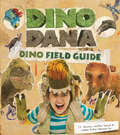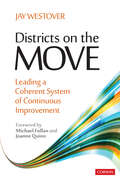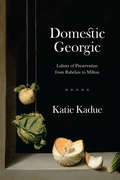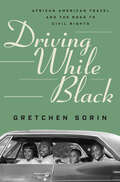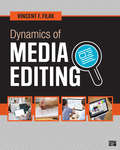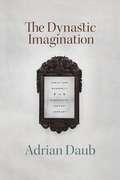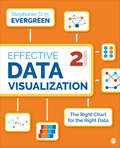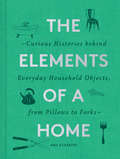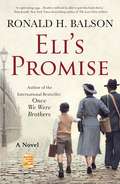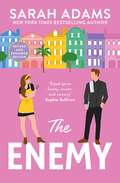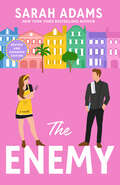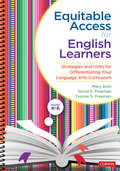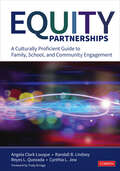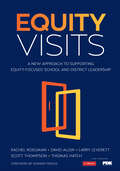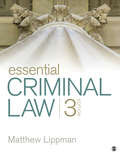- Table View
- List View
Dino Dana: Dino Field Guide
by J.J. Johnson Christin Simms Colleen Russo JohnsonA Dino Dana Field Guide of Dinosaurs for Kids (Ages 8-12)“This field guide is great for new and old dinosaur lovers. It alphabetically introduces dinosaurs and information about when and where they lived along with other tidbits about them. It is good for fun reading and can be used in homeschooling.” ―JustaBXMomNominated for Four Daytime Emmy® Awards#1 Bestseller in Children's Fossil BooksFun facts about dinosaurs for kids. Did you know that the brachiosaurus was the tallest dinosaur that we know of today? That the kosmoceratops had fifteen horns and hooks on its head? That the spinosaurus is the only known dinosaur to spend most of its time swimming? Discover this and much more in Dino Dana: Dino Field Guide.Dino Dana's field guide for your child. Fans of the Amazon Prime TV show Dino Dana will be so excited to have a Dino Field Guide of their own, put together by the incredible show's creator and executive producer, J. J. Johnson. Full of colorful illustrations and fascinating science facts, this dinosaur book is sure to amaze any young dino enthusiast.A great science book for kids. This book for children is perfect for any kid who likes history and science. In the Dino Dana field guide, your kids learn:Which time period each dinosaur lived inHow big the dinosaurs wereWhat kinds of things dinosaurs ate and did each dayAnd so much moreKids who like cool dinosaur books like Dinosaurs, National Geographic Little Kids First Big Book of Dinosaurs, The Big Book of Dinosaurs, or The Dinosaur Book will love Dino Dana: Dino Field Guide.
Disaster Policy and Politics: Emergency Management and Homeland Security
by Richard T. SylvesDisaster Policy and Politics combines evidence-based research with mini-case studies of recent events to demonstrate the fundamental principles of emergency management and to explore the impact that disasters have had on U.S. policy. Paying special attention to the role of key actors—decision makers at the federal, state, and local levels; scientists; engineers; civil and military personnel; and first responders—author Richard Sylves explores how researchers contribute to and engage in disaster policy development and management. The highly anticipated Third Edition explores the radical change in policy and politics after the occurrence of recent disasters such as hurricanes Irma, Maria, and Harvey; Hawaii′s false nuclear attack warning; and responses to U.S. wildfires. The book’s comprehensive "all-hazards" approach introduces students to the important public policy, organizational management, and leadership issues they may need as future practitioners and leaders in the field.
Disaster Policy and Politics: Emergency Management and Homeland Security
by Richard T. SylvesDisaster Policy and Politics combines evidence-based research with mini-case studies of recent events to demonstrate the fundamental principles of emergency management and to explore the impact that disasters have had on U.S. policy. Paying special attention to the role of key actors—decision makers at the federal, state, and local levels; scientists; engineers; civil and military personnel; and first responders—author Richard Sylves explores how researchers contribute to and engage in disaster policy development and management. The highly anticipated Third Edition explores the radical change in policy and politics after the occurrence of recent disasters such as hurricanes Irma, Maria, and Harvey; Hawaii′s false nuclear attack warning; and responses to U.S. wildfires. The book’s comprehensive "all-hazards" approach introduces students to the important public policy, organizational management, and leadership issues they may need as future practitioners and leaders in the field.
Districts on the Move: Leading a Coherent System of Continuous Improvement
by Jay Allen WestoverBuilding off the framework Fullan and Quinn introduced in the International best-seller Coherence The Right Drivers in Action for Schools, Districts, and Systems, Westover presents a roadmap to help district and school leaders navigate the journey of creating a coherent system of continuous improvement. Based on more than 15 years of successful partnerships with school districts, this book includes case studies of how districts progressed over time, leadership competencies shown to be critical factors for success, tools and rubrics for action planning and guiding implementation, and reflective questions for inquiring about the current state of district systems and practices and strategies for systemic improvements efforts. Readers will discover Benchmarks of Capacity that will serve as guideposts to • Create clarity of district goals and school priorities for student learning • Cultivate a culture of shared leadership and systemic collaboration • Develop collective expertise with a coherent instructional framework • Engage in evidence-based cycles of inquiry for continuous improvement Learn how to lead systemic improvement that builds capacity at the classroom, school and district levels.
Districts on the Move: Leading a Coherent System of Continuous Improvement
by Jay Allen WestoverBuilding off the framework Fullan and Quinn introduced in the International best-seller Coherence The Right Drivers in Action for Schools, Districts, and Systems, Westover presents a roadmap to help district and school leaders navigate the journey of creating a coherent system of continuous improvement. Based on more than 15 years of successful partnerships with school districts, this book includes case studies of how districts progressed over time, leadership competencies shown to be critical factors for success, tools and rubrics for action planning and guiding implementation, and reflective questions for inquiring about the current state of district systems and practices and strategies for systemic improvements efforts. Readers will discover Benchmarks of Capacity that will serve as guideposts to • Create clarity of district goals and school priorities for student learning • Cultivate a culture of shared leadership and systemic collaboration • Develop collective expertise with a coherent instructional framework • Engage in evidence-based cycles of inquiry for continuous improvement Learn how to lead systemic improvement that builds capacity at the classroom, school and district levels.
Domestic Georgic: Labors of Preservation from Rabelais to Milton
by Katie KadueInspired by Virgil’s Georgics, this study conceptualizes Renaissance poetry as a domestic labor. When is literary production more menial than inspired, more like housework than heroics of the mind? In this revisionist study, Katie Kadue shows that some of the authors we credit with groundbreaking literary feats—including Michel de Montaigne and John Milton—conceived of their writing in surprisingly modest and domestic terms. In contrast to the monumental ambitions associated with the literature of the age, and picking up an undercurrent of Virgil’s Georgics, poetic labor of the Renaissance emerges here as often aligned with so-called women’s work. Kadue reveals how male authors’ engagements with a feminized georgic mode became central to their conceptions of what literature is and could be. This other georgic strain in literature shared the same primary concern as housekeeping: the necessity of constant, almost invisible labor to keep the things of the world intact. Domestic Georgic brings into focus a conception of literary—as well as scholarly and critical—labor not as a striving for originality and fame but as a form of maintenance work that aims at preserving individual and collective life.
Driving While Black: African American Travel And The Road To Civil Rights
by Gretchen SorinBloomberg • Best Nonfiction Books of 2020: "[A] tour de force." The basis of a major PBS documentary by Ric Burns, this “excellent history” (The New Yorker) reveals how the automobile fundamentally changed African American life. Driving While Black demonstrates that the car—the ultimate symbol of independence and possibility—has always held particular importance for African Americans, allowing black families to evade the dangers presented by an entrenched racist society and to enjoy, in some measure, the freedom of the open road. Melding new archival research with her family’s story, Gretchen Sorin recovers a lost history, demonstrating how, when combined with black travel guides—including the famous Green Book—the automobile encouraged a new way of resisting oppression.
Dynamics of Media Editing
by Vincent F. FilakAs traditional newsrooms staffed by journalists and managed by experienced editors become less and less common, there is an even greater need for all types of professional writers to be fluent in the editorial process. Dynamics of Media Editing emphasizes the broad value of editing as both a tool for journalistic management and an essential skill for individual writers of all stripes. Author Vince F. Filak recognizes editing as an essential process for improving the quality of published writing, something that is relevant and essential to investigative journalists, social media interns, celebrity bloggers, and everyone in between. By organizing the book around skills and by platforms, Dynamics of Media Editing shows students how the basic principles of good editing work across disciplines and media platforms. Key Features The emphasis on transferrable skills and multiple platforms shows students how to use the basic principles of good editing for journalism, PR, advertising, or social media marketing. The book takes a broad approach to editing, demonstrating that it’s not just a skill for managers at newspapers, but rather an essential process for improving all aspects of published writing. This addresses a critical course challenge, in that many students don’t see the relevance of editing in their planned careers. The audience-centric method emphasizes the need to engage one’s audience in order to be a successful writer. "Helpful Hints" boxes provide easy-to-consult lists of dos and don’ts for good writing. "Thoughts From a Pro" boxes allow media professionals from a variety of backgrounds to demonstrate the essential function of the editing process in the workplace.
Dynamics of Media Editing
by Vincent F. FilakAs traditional newsrooms staffed by journalists and managed by experienced editors become less and less common, there is an even greater need for all types of professional writers to be fluent in the editorial process. Dynamics of Media Editing emphasizes the broad value of editing as both a tool for journalistic management and an essential skill for individual writers of all stripes. Author Vince F. Filak recognizes editing as an essential process for improving the quality of published writing, something that is relevant and essential to investigative journalists, social media interns, celebrity bloggers, and everyone in between. By organizing the book around skills and by platforms, Dynamics of Media Editing shows students how the basic principles of good editing work across disciplines and media platforms. Key Features The emphasis on transferrable skills and multiple platforms shows students how to use the basic principles of good editing for journalism, PR, advertising, or social media marketing. The book takes a broad approach to editing, demonstrating that it’s not just a skill for managers at newspapers, but rather an essential process for improving all aspects of published writing. This addresses a critical course challenge, in that many students don’t see the relevance of editing in their planned careers. The audience-centric method emphasizes the need to engage one’s audience in order to be a successful writer. "Helpful Hints" boxes provide easy-to-consult lists of dos and don’ts for good writing. "Thoughts From a Pro" boxes allow media professionals from a variety of backgrounds to demonstrate the essential function of the editing process in the workplace.
The Dynastic Imagination: Family and Modernity in Nineteenth-Century Germany
by Adrian DaubAdrian Daub’s The Dynastic Imagination offers an unexpected account of modern German intellectual history through frameworks of family and kinship. Modernity aimed to brush off dynastic, hierarchical authority and to make society anew through the mechanisms of marriage, siblinghood, and love. It was, in other words, centered on the nuclear family. But as Daub shows, the dynastic imagination persisted, in time emerging as a critical stance by which the nuclear family’s conservatism and temporal limits could be exposed. Focusing on the complex interaction between dynasties and national identity-formation in Germany, Daub shows how a lingering preoccupation with dynastic modes of explanation, legitimation, and organization suffused German literature and culture. ? Daub builds this conception of dynasty in a syncretic study of literature, sciences, and the history of ideas, engaging with remnants of dynastic ideology in the work of Richard Wagner, Émile Zola, and Stefan George, and in the work of early feminists and pioneering psychoanalysts. At every stage of cultural progression, Daub reveals how the relation of dynastic to nuclear families inflected modern intellectual history.
Effective Data Visualization: The Right Chart for the Right Data
by Stephanie EvergreenNOW IN FULL COLOR! Written by sought-after speaker, designer, and researcher Stephanie D. H. Evergreen, Effective Data Visualization shows readers how to create Excel charts and graphs that best communicate their data findings. This comprehensive how-to guide functions as a set of blueprints—supported by both research and the author’s extensive experience with clients in industries all over the world—for conveying data in an impactful way. Delivered in Evergreen’s humorous and approachable style, the book covers the spectrum of graph types available beyond the default options, how to determine which one most appropriately fits specific data stories, and easy steps for building the chosen graph in Excel. Now in full color with new examples throughout, the Second Edition includes a revamped chapter on qualitative data, nine new quantitative graph types, new shortcuts in Excel, and an entirely new chapter on Sharing Your Data With the World, which provides advice on using dashboards. New from Stephanie Evergreen! The Data Visualization Sketchbook provides advice on getting started with sketching and offers tips, guidance, and completed sample sketches for a number of reporting formats. Bundle Effective Data Visualization, 2e, and The Data Visualization Sketchbook, using ISBN 978-1-5443-7178-8!
Effective Data Visualization: The Right Chart for the Right Data
by Stephanie EvergreenNOW IN FULL COLOR! Written by sought-after speaker, designer, and researcher Stephanie D. H. Evergreen, Effective Data Visualization shows readers how to create Excel charts and graphs that best communicate their data findings. This comprehensive how-to guide functions as a set of blueprints—supported by both research and the author’s extensive experience with clients in industries all over the world—for conveying data in an impactful way. Delivered in Evergreen’s humorous and approachable style, the book covers the spectrum of graph types available beyond the default options, how to determine which one most appropriately fits specific data stories, and easy steps for building the chosen graph in Excel. Now in full color with new examples throughout, the Second Edition includes a revamped chapter on qualitative data, nine new quantitative graph types, new shortcuts in Excel, and an entirely new chapter on Sharing Your Data With the World, which provides advice on using dashboards. New from Stephanie Evergreen! The Data Visualization Sketchbook provides advice on getting started with sketching and offers tips, guidance, and completed sample sketches for a number of reporting formats. Bundle Effective Data Visualization, 2e, and The Data Visualization Sketchbook, using ISBN 978-1-5443-7178-8!
The Elements of a Home: Curious Histories behind Everyday Household Objects, from Pillows to Forks
by Amy AzzaritoThe Elements of a Home reveals the fascinating stories behind more than 60 everyday household objects and furnishings. Brimming with amusing anecdotes and absorbing trivia, this captivating collection is a treasure trove of curiosities.With tales from the kitchen, the bedroom, and every room in between, these pages expose how napkins got their start as lumps of dough in ancient Greece, why forks were once seen as immoral tools of the devil, and how Plato devised one of the earliest alarm clocks using rocks and water—plus so much more.• A charming book for anyone who loves history, design, or décor• Readers discover tales from every nook and cranny of a home.• Entries feature historical details from locations all over the world, including Europe, Asia, North America, and Africa.As a design historian and former managing editor of Design*Sponge, author Amy Azzarito has crafted an engaging, whimsical history of the household objects you've never thought twice about.The result is a fascinating book filled with tidbits from a wide range of cultures and places about the history of domestic luxury.• Filled with lovely illustrations by Alice Pattullo• Perfect for anyone who adores interior design, trivia, history, and unique facts• Great for those who enjoyed The Greatest Stories Never Told: 100 Tales from History to Astonish, Bewilder, and Stupefy by Rick Beyer, An Uncommon History of Common Things by Bethanne Patrick and John Thompson, Encyclopedia of the Exquisite: An Anecdotal History of Elegant Delights by Jessica Kerwin Jenkins
Eli's Promise: A Novel
by Ronald H. Balson"National Jewish Book Award winner Ron Balson returns triumphantly with Eli’s Promise, a captivating saga of the Holocaust and its aftermath spanning decades and continents. Readers will not be able to put this book down, but will turn the pages compulsively with heart in throat, eager to learn the fate of the Rosen family. Balson’s meticulous historical detail, vivid prose and unforgettable characters further solidify his place among the most esteemed writers of historical fiction today."—Pam Jenoff, New York Times Bestselling Author of The Lost Girls of Paris A "fixer" in a Polish town during World War II, his betrayal of a Jewish family, and a search for justice 25 years later—by the winner of the National Jewish Book Award.Eli's Promise is a masterful work of historical fiction spanning three eras—Nazi-occupied Poland, the American Zone of post-war Germany, and Chicago at the height of the Vietnam War. Award-winning author Ronald H. Balson explores the human cost of war, the mixed blessings of survival, and the enduring strength of family bonds.1939: Eli Rosen lives with his wife Esther and their young son in the Polish town of Lublin, where his family owns a construction company. As a consequence of the Nazi occupation, Eli’s company is Aryanized, appropriated and transferred to Maximilian Poleski—an unprincipled profiteer who peddles favors to Lublin’s subjugated residents. An uneasy alliance is formed; Poleski will keep the Rosen family safe if Eli will manage the business. Will Poleski honor his promise or will their relationship end in betrayal and tragedy?1946: Eli resides with his son in a displaced persons camp in Allied-occupied Germany hoping for a visa to America. His wife has been missing since the war. One man is sneaking around the camps selling illegal visas; might he know what has happened to her?1965: Eli rents a room in Albany Park, Chicago. He is on a mission. With patience, cunning, and relentless focus, he navigates unfamiliar streets and dangerous political backrooms, searching for the truth. Powerful and emotional, Ronald H. Balson's Eli's Promise is a rich, rewarding novel of World War II and a husband’s quest for justice.
Enamorada del Gemelo Equivocado (High School Players #4)
by Anna Katmore¡Nunca confíes en un gemelo! Sue quiere a Ethan, y Chris quiere a Sue. Atraída por Ethan e intrigada por Chris, Susan Miller se encuentra atrapada entre hermanos gemelos idénticos en su escuela. Cuando ambos comienzan a cortejarla al mismo tiempo, solo tiene que elegir. ¿Cierto? ¡Incorrecto! Ethan es reacio a besarla, y Chris la quiere por razones completamente equivocadas. Nada como su amable y dulce hermano, Chris Donovan tiene la palabra problema escrita sobre él. Él cambia a las chicas como otros chicos cambian las camisetas, y el próximo trofeo en su pequeña lista es Susan. Eso es lo último que quiere, pero se encuentra respondiendo a todos los mensajes de buenas noches y otros mensajes descarados que envía Chris. El chico tiene una forma de meterse debajo de su piel como nadie lo ha hecho antes. ¿Cuánto tiempo pasará hasta que Susan se enamore de su suave encanto y se meta en más problemas de los que posiblemente pueda manejar? ¿Y dónde deja eso a Ethan?
The Enemy: An EXTENDED edition rom-com from the author of the TikTok sensation THE CHEAT SHEET (It Happened in Charleston #2)
by Sarah Adams'Equal parts funny, sweet and swoony' SOPHIE SULLIVANFrom the New York Times bestselling author of The Cheat Sheet and Practice Makes Perfect comes an expanded edition of The Enemy - a laugh-out-loud romance about rekindling old flames, with a never-before-seen chapter.Enemies should never get a second chance. But this one might . . .It's been twelve years since June Broaden has seen her high school enemy (and secret crush), Ryan Henderson. That's a long time to hold a grudge over some petty feud, but the sharp memory of him dangling a kiss at graduation, then pulling away at the last second, has fuelled many angry fantasies since. Now's her chance to get even.Ryan, along with most of her high school class, is back in town for her best friend's wedding, and June is eager to show the former bully exactly what he missed out on. A lot has changed since their high school days; June is the Southern queen of gourmet donuts now, not to mention one of the most desired bachelorettes in her small town.What's she's not expecting, though, is for Ryan to show up looking like Adonis and touting his own career success as the youngest chef to ever win three Michelin stars. How dare he try to one up her revenge plot? Luckily June never backs down from a challenge . . .
The Enemy: A Novel (It Happened In Charleston Ser.)
by Sarah AdamsFrom the New York Times bestselling author of Practice Makes Perfect comes an expanded edition of The Enemy—a laugh-out-loud romance about rekindling old flames, with a never-before-seen chapter.Enemies should never get a second chance. But this one might.It&’s been twelve years since June Broaden has seen her high school enemy (and secret crush), Ryan Henderson. That&’s a long time to hold a grudge over some petty feud, but the sharp memory of him dangling a kiss at graduation, then pulling away at the last second, has fueled many angry fantasies since. Now it&’s her chance to get even.Ryan, along with most of her high school class, is back in town for her best friend&’s wedding, and June is eager to show the former bully exactly what he&’s missed out on. A lot has changed since their teenage days; June is now the Southern queen of gourmet donuts , not to mention one of the most desired bachelorettes in her small town.What&’s she&’s not expecting, though, is for Ryan to show up looking like Adonis and touting his own career success as the youngest chef to ever win three Michelin stars. How dare he try to one-up her revenge plot? Luckily, June never backs down from a challenge.
Entzückt von einem Herzog
by Amanda MarielMiss Emma Baxter flieht als blinde Passagierin in einer Kutsche, um ihrem Onkel und dem Baron zu entkommen, mit dem sie verheiratet werden soll. Das Letzte, was sie erwartet hätte, ist, sich plötzlich an der Seite von Aaron St. John, dem Herzog von Radcliffe, und seiner sieben Jahre alten Tochter Lady Sophia wiederzufinden. Nun ist sie von einer gänzlich anderen Gefahr bedroht.
Equitable Access for English Learners, Grades K-6: Strategies and Units for Differentiating Your Language Arts Curriculum
by Yvonne S. Freeman David E. Freeman Mary SotoPlain and simple: until our English learners have equitable access to the curriculum, they’ll continue to struggle with subject area content. And if you’re relying on add-on’s to fit in from your language arts basal or a supplementary program, Mary Soto, David Freeman, and Yvonne Freeman are here to equip you with much more effective, efficient, and engaging strategies for helping your English learners read and write at grade level. One assurance right from the start: Mary, David, and Yvonne are not suggesting you reinvent your curriculum. Instead, Equitable Access for English Learners, Grades K-6, focuses on how to fortify foundational practices already in place. First, you’ll learn more about the Equitable Access Approach, then it’s time to dive into the book’s four units of study. Drawing on each unit’s many strategies, you’ll discover how to apply them to any unit in your own language arts curriculum and start differentiating: How to draft and implement language objectives to help English learners meet academic content standards How to make instructional input comprehensible, including translanguaging strategies that draw on your students’ first languages when you don’t know how to speak them How to utilize the characteristics of text to support readers, along with a rubric for determining a text’s cultural relevance How to build students’ academic content knowledge and develop academic language proficiency Each unit addresses a commonly taught topic in today’s language arts programs and comes with ready-to-go review and preview activities, key strategies, grade-level adaptations, reflection exercises, and printable online resources. Taken as a whole, they constitute an all-new approach for providing that equitable and excellent access our English learners so rightfully deserve. "When you adopt our Equitable Access Approach, your students will not only thrive, they’ll also find your language arts curriculum much more meaningful and engaging." —Mary Soto, David E. Freeman, and Yvonne S. Freeman
Equitable Access for English Learners, Grades K-6: Strategies and Units for Differentiating Your Language Arts Curriculum
by Yvonne S. Freeman David E. Freeman Mary SotoPlain and simple: until our English learners have equitable access to the curriculum, they’ll continue to struggle with subject area content. And if you’re relying on add-on’s to fit in from your language arts basal or a supplementary program, Mary Soto, David Freeman, and Yvonne Freeman are here to equip you with much more effective, efficient, and engaging strategies for helping your English learners read and write at grade level. One assurance right from the start: Mary, David, and Yvonne are not suggesting you reinvent your curriculum. Instead, Equitable Access for English Learners, Grades K-6, focuses on how to fortify foundational practices already in place. First, you’ll learn more about the Equitable Access Approach, then it’s time to dive into the book’s four units of study. Drawing on each unit’s many strategies, you’ll discover how to apply them to any unit in your own language arts curriculum and start differentiating: How to draft and implement language objectives to help English learners meet academic content standards How to make instructional input comprehensible, including translanguaging strategies that draw on your students’ first languages when you don’t know how to speak them How to utilize the characteristics of text to support readers, along with a rubric for determining a text’s cultural relevance How to build students’ academic content knowledge and develop academic language proficiency Each unit addresses a commonly taught topic in today’s language arts programs and comes with ready-to-go review and preview activities, key strategies, grade-level adaptations, reflection exercises, and printable online resources. Taken as a whole, they constitute an all-new approach for providing that equitable and excellent access our English learners so rightfully deserve. "When you adopt our Equitable Access Approach, your students will not only thrive, they’ll also find your language arts curriculum much more meaningful and engaging." —Mary Soto, David E. Freeman, and Yvonne S. Freeman
Equity Partnerships: A Culturally Proficient Guide to Family, School, and Community Engagement
by Randall B. Lindsey Reyes L. Quezada Cynthia L. Jew Angela R. Clark-LouqueHow often do you hear, "The only parents who showed were the parents who didn’t need to be here." But how often do you consider time of day, lack of child care, cost of dinner, transportation, language of the presentation, even relevance of the topic—all real-world barriers for families of our historically underserved students. Here at last is a resource that will open up access and reveal all-new ways to forge more culturally inclusive partnerships with families and communities . . . partnerships that extend well beyond parent-teacher conferences, PTA meetings, and the occasional bake sale. The two big services Equity Partnerships provides? Using the Tools of Cultural Proficiency, you’ll Discover new concepts and strategies to engage families and communities—and reduce, if not eliminate, barriers--through four essential principles: communication, connection, collaboration, and community Engage in frequent opportunities to reflect on your own assumptions and values, then collaborate with colleagues to co-create systemic practices and policies for devising, implementing, and assessing family and community engagement actions in your schools and districts We know inherently that family and community engagement is critical to the success of our students. Let Equity Partnerships be your go-to tool for breaking down the walls that for too long have limited all of us. "Raising the next generation is a shared responsibility and privilege. These authors have been first responders for decades by promoting Cultural Proficiency as a means to ensure equity and access for all. In Equity Partnerships, they identify the powerful and critical link of family, school, and community engagement to strengthen families, build community support, and increase student success." --TRUDY ARRIAGA, Associate Dean for Equity and Outreach, California Lutheran University, and Coauthor of Opening Doors
Equity Partnerships: A Culturally Proficient Guide to Family, School, and Community Engagement
by Randall B. Lindsey Reyes L. Quezada Cynthia L. Jew Angela R. Clark-LouqueHow often do you hear, "The only parents who showed were the parents who didn’t need to be here." But how often do you consider time of day, lack of child care, cost of dinner, transportation, language of the presentation, even relevance of the topic—all real-world barriers for families of our historically underserved students. Here at last is a resource that will open up access and reveal all-new ways to forge more culturally inclusive partnerships with families and communities . . . partnerships that extend well beyond parent-teacher conferences, PTA meetings, and the occasional bake sale. The two big services Equity Partnerships provides? Using the Tools of Cultural Proficiency, you’ll Discover new concepts and strategies to engage families and communities—and reduce, if not eliminate, barriers--through four essential principles: communication, connection, collaboration, and community Engage in frequent opportunities to reflect on your own assumptions and values, then collaborate with colleagues to co-create systemic practices and policies for devising, implementing, and assessing family and community engagement actions in your schools and districts We know inherently that family and community engagement is critical to the success of our students. Let Equity Partnerships be your go-to tool for breaking down the walls that for too long have limited all of us. "Raising the next generation is a shared responsibility and privilege. These authors have been first responders for decades by promoting Cultural Proficiency as a means to ensure equity and access for all. In Equity Partnerships, they identify the powerful and critical link of family, school, and community engagement to strengthen families, build community support, and increase student success." --TRUDY ARRIAGA, Associate Dean for Equity and Outreach, California Lutheran University, and Coauthor of Opening Doors
Equity Visits: A New Approach to Supporting Equity-Focused School and District Leadership
by David Allen Larry Leverett Scott T. Thompson Thomas C. Hatch Rachel D. RoegmanBecause equity and instruction are inextricably bound Why are equity visits such a critical first step to increasing opportunity and access for our under-served students? Because they take instructional rounds to a new level, providing a powerful lens for investigating the intersections of equity and instruction. After all, how can we possibly deliver equitable learning experiences, opportunities, and outcomes for our students, without first pinpointing problems of practice? That’s where Equity Visits will prove absolutely indispensable to district and school administrators. It details how to combine a strong focus on instruction with explicit, intentional efforts to address systemic inequities. Inside you’ll find A range of data collection activities and tools to target central issues of equity in your school Clear guidelines on how to investigate the ways instructional practices, structures, and beliefs lead to inequitable educational experiences—and how these are often masked in the day-to-day life of schools and districts A frank discussion of how to make race and racism an explicit part of investigating and addressing educational inequities Voices of school and district leaders who have taken crucial first steps to become "equity warriors" Recommendations on how to develop policies, initiatives, and practices to confront those inequities Few dispute that instructional improvement must be a central focus of educational leadership, but for too long achieving educational equity has been absent from the conversation. Here is your opportunity to ensure equity occupy a central spot in data collection and analysis, and be explicitly discussed at all levels of your school or district organization. In short, essential reading and doing for all administrators!
Equity Visits: A New Approach to Supporting Equity-Focused School and District Leadership
by David Allen Larry Leverett Scott T. Thompson Thomas C. Hatch Rachel D. RoegmanBecause equity and instruction are inextricably bound Why are equity visits such a critical first step to increasing opportunity and access for our under-served students? Because they take instructional rounds to a new level, providing a powerful lens for investigating the intersections of equity and instruction. After all, how can we possibly deliver equitable learning experiences, opportunities, and outcomes for our students, without first pinpointing problems of practice? That’s where Equity Visits will prove absolutely indispensable to district and school administrators. It details how to combine a strong focus on instruction with explicit, intentional efforts to address systemic inequities. Inside you’ll find A range of data collection activities and tools to target central issues of equity in your school Clear guidelines on how to investigate the ways instructional practices, structures, and beliefs lead to inequitable educational experiences—and how these are often masked in the day-to-day life of schools and districts A frank discussion of how to make race and racism an explicit part of investigating and addressing educational inequities Voices of school and district leaders who have taken crucial first steps to become "equity warriors" Recommendations on how to develop policies, initiatives, and practices to confront those inequities Few dispute that instructional improvement must be a central focus of educational leadership, but for too long achieving educational equity has been absent from the conversation. Here is your opportunity to ensure equity occupy a central spot in data collection and analysis, and be explicitly discussed at all levels of your school or district organization. In short, essential reading and doing for all administrators!
Essential Criminal Law
by Matthew LippmanEssential Criminal Law provides a highly accessible introduction to U.S. criminal law that helps students, including those with no prior exposure to case law, build their legal reasoning skills. Drawing from more than 30 years of teaching experience, best-selling author Matthew Lippman guides readers through the complexities of the legal system using thought-provoking examples of real-life crimes and legal defenses, along with approachable case analyses. The Third Edition keep readers up to date with coverage of timely topics and the most current developments in criminal law and public policy.
